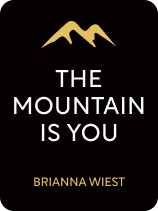

This article is an excerpt from the Shortform book guide to "The Mountain Is You" by Brianna Wiest. Shortform has the world's best summaries and analyses of books you should be reading.
Like this article? Sign up for a free trial here.
What are self-regulation skills? Why are these skills important in life?
Self-regulation is the ability to manage and understand your emotions so you react to things in a better way. The Mountain Is You by Brianna Wiest explains how self-regulation skills come a long way when it comes to overcoming self-sabotaging behavior.
Continue reading to learn why you need self-regulation skills in life.
Strengthen Your Self-Regulation Skills
Once you’ve identified your self-sabotaging behaviors and the mental-emotional (ME) deficits that are causing them, Wiest explains that you must take active, and sometimes uncomfortable, steps to overcome them. First, you must strengthen your self-regulation skills by learning how to follow your instincts and effectively interpret, process, and respond to your emotions. Once you’ve improved your self-regulation skills, you must identify your ideal self and life purpose and take steps to achieve them.
Strategy #1: Follow Your Intuition and Release Your Fears
Wiest explains that you can overcome your self-sabotaging behaviors by listening to your intuition (your instinctive understanding of how to act) and differentiating it from your fears. This is because while self-sabotaging behaviors are driven by your fears, productive behaviors are often driven by your intuition. If you learn how to get in touch with your intuition, you can consciously override self-sabotaging behaviors and replace them with actions that bring improvement and progress toward goals.
(Shortform note: Wiest argues that listening to your fears is bad because it causes self-sabotage. However, in The 10x Rule, Grant Cardone argues that listening to your fears is beneficial and might even help you get in touch with your intuition. Fear can be an indication that you’re on the right track because you’re pushing yourself outside your comfort zone—an activity Wiest also says is necessary for growth. Additionally, the more you get comfortable understanding and facing your fears, the more you will be able to grow.)
To follow your intuition rather than your fears, recognize when your thoughts or feelings are driving you toward a certain action or behavior, and take a moment to reflect. Wiest explains that we’re often subconsciously driven by our fears because they’re louder and more prominent than our intuition. Fears tend to manifest when we think we know what will happen in the future, worry about something, panic, have an emotional reaction like getting angry or jealous or feel pumped up with adrenaline. If you find yourself being driven to act based on any of these factors, take a step back and acknowledge that your fears are pushing you toward self-sabotage.
(Shortform note: In The Gifts of Imperfection, Brené Brown adds that our fears often override our intuition because we’re programmed to avoid uncertainty. Rather than following our subtle gut instincts blindly, we try to predict outcomes and choose the path of least resistance. Adding to Wiest’s recommendation, Brown notes that we can avoid following our fears and focus more on our intuition by having faith—adopting the mindset that things will work out fine in the end, even if you’re uncertain of how that will happen.)
Wiest notes that in contrast to fear, intuition is the quiet, internal responses you get when you’re in tune with the present moment—they often manifest as moments of clarity (for example, determining that you enjoy or dislike something) or peacefulness (feeling content, happy, or inspired). To get in touch with your intuition, focus on the present moment rather than the future—reflect on how you’re currently feeling and respond to what’s currently happening.
For instance, if you feel content and peaceful doing something, you should probably find a way to engage in that activity more often—recognizing what brings you contentment may even lead to uncovering your life purpose. Likewise, if you don’t feel content or happy doing something, you should probably spend less time engaging in that activity.
(Shortform note: In 10% Happier, Dan Harris refers to the idea of focusing on the present moment and your current feelings as mindfulness. He elaborates that another important component of mindfulness is emotional detachment—acknowledging feelings and sensations but not letting them control you. This will allow you to understand the emotions that you’re feeling without permitting them to hijack your mind and cause self-sabotage.)
Strategy #2: Effectively Interpret and Respond to Your Emotions
To listen to your instincts rather than your fears and avoid self-sabotage, Wiest explains that you must also learn how to effectively interpret and respond to your emotions—emotions (like anxiety or discomfort) are what trigger fears that cause self-sabotage. When you’re able to recognize the emotions you’re feeling and understand why you’re feeling them, you’ll be better equipped to determine whether they stem from intuition (the gut feeling that something’s right or wrong) or fear.
Wiest explains that the first step in accurately interpreting your emotions is to identify what you’re feeling and accept it. For example, if you’re feeling angry, acknowledge the emotion and let yourself feel it. If you try to stifle your emotions rather than letting them run their course, they’ll just build up inside you, make you feel worse, and contribute to more self-sabotaging behaviors.
(Shortform note: Wiest advises identifying the emotion you’re feeling so you can accept it, but she doesn’t provide specific advice on how to do this. Many people struggle to identify how they’re feeling or misidentify their emotions due to poor emotional vocabulary. To accurately label the emotions you’re feeling so you can effectively process them, experts recommend first broadening your emotional vocabulary. This includes learning how to differentiate an emotion like anger from other emotions like frustration or contempt. Second, the next time you feel a strong emotion, rate how strongly you’re feeling it from one to 10. Finally, make it a habit to write out the emotions you’re feeling. This will help you identify them more easily in the future.)
Next, interpret your emotions by pinpointing why you’re feeling them. Emotions usually indicate an action we need to take. Wiest explains that anger usually indicates what we care about and encourages us to act to achieve it. Jealousy usually indicates something that we want but don’t have. Resentment usually indicates that someone hasn’t lived up to our expectations of them. Regret usually indicates that we missed out on something in the past.
Once you uncover why you’re feeling an emotion, you can consciously determine the best course of action to avoid self-sabotage and instead take actions that will improve your life. For example, if you feel resentment toward someone, you can have a productive discussion with them about the problem rather than acting poorly and ruining your relationship. If you’re feeling regret after passing up a job opportunity, you can use that feeling to guide you by seeking out job opportunities that are similar to the one you passed up.
How to Interpret Emotions
Determining why you feel a certain way and what to do about it can be difficult. However, in Awaken The Giant Within, Tony Robbins presents a concrete method to help you do just that.
Robbins explains that when you feel a negative emotion, you need to either change the beliefs that are causing you to feel that way, or change your actions to avoid the negative feeling in the future. To determine what needs to be done, ask yourself: What do I want to feel instead? What belief is causing me to feel this way? What can I do to resolve or prevent what’s causing this pain? What can I learn from this situation?
For example, when another driver cuts you off, you may feel angry due to a belief that their behavior is caused by selfishness. However, you might prevent feeling and acting out of anger by instead considering the other driver’s needs and leaving extra room for them to merge into your lane. A potential lesson is that empathy and attention to others’ needs can preempt anger for both you and others.

———End of Preview———
Like what you just read? Read the rest of the world's best book summary and analysis of Brianna Wiest's "The Mountain Is You" at Shortform.
Here's what you'll find in our full The Mountain Is You summary:
- Why the only thing standing in your way of achieving your goals is you
- How to achieve your life purpose and become your ideal self
- How to identify your self-sabotaging behaviors and stop them






